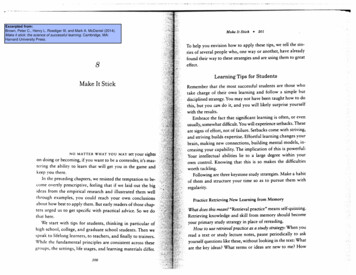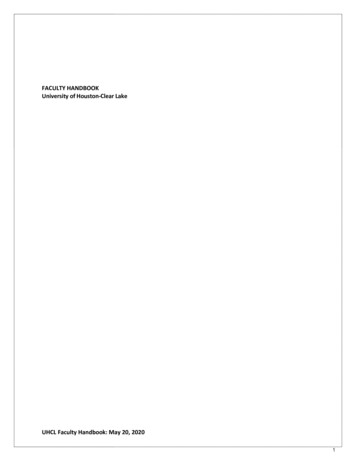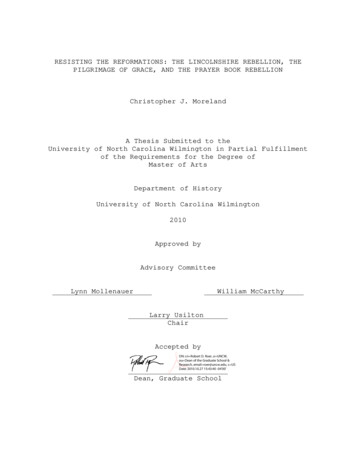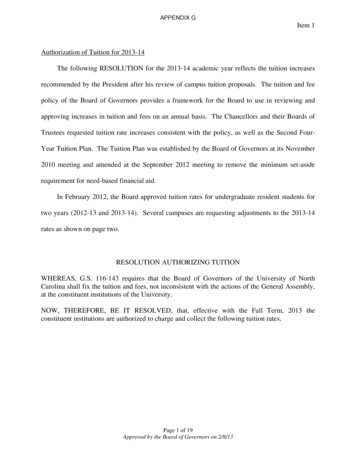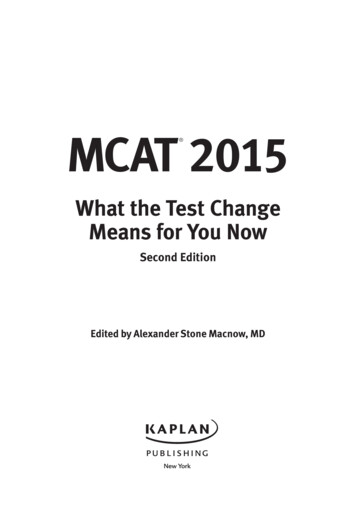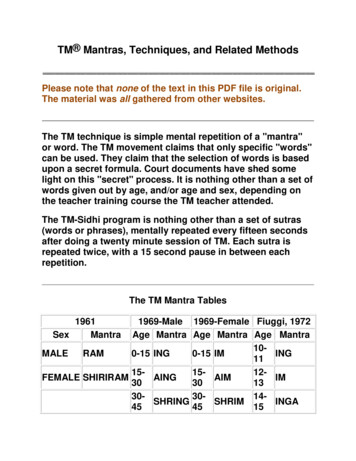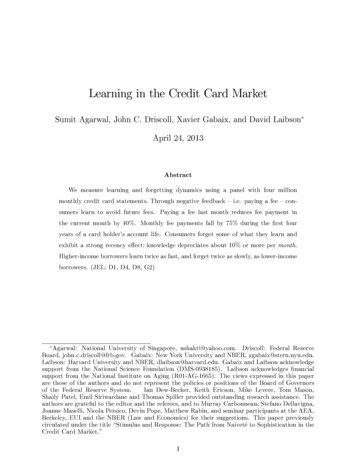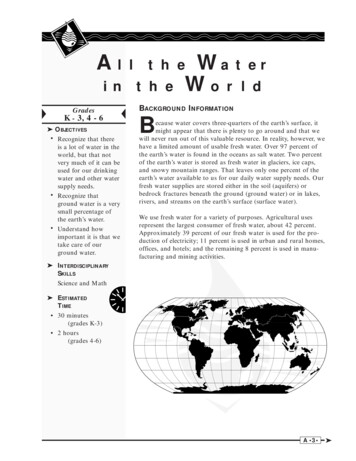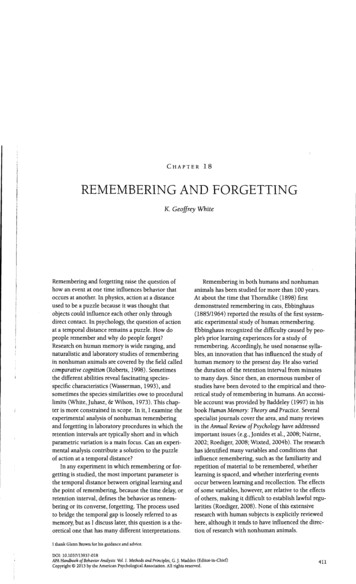
Transcription
CHAPTER18REMEMBERING AND FORGETTINGK. Geoffrey WhiteRemembering and forgetting raise the question ofhow an event at one time influences behavior thatoccurs at another. In physics, action at a distanceused to be a puzzle because it was thought thatobjects could influence each other only throughdirect contact. In psychology, the question of actionat a temporal distance remains a puzzle. How dopeople remember and why do people forget?Research on human memory is wide ranging, andnaturalistic and laboratory studies of rememberingin nonhuman animals are covered by the field calledcomparative cognition (Roberts, 1998). Sometimesthe different abilities reveal fascinating species specific characteristics (Wasserman, 1993), andsometimes the species similarities owe to procedurallimits (White,Juhasz, &: Wilson, 1973). This chap ter is more constrained in scope. In it, I examine theexperimental analysis of nonhuman rememberingand forgetting in laboratory procedures in which theretention intervals are typically short and in whichparametric variation is a main focus. Can an experi mental analysis contribute a solution to the puzzleof action at a temporal distance?In any experiment in which remembering or for getting is studied, the most important parameter isthe temporal distance between original learning andthe point of remembering, because the time delay, orretention interval, defines the behavior as remem bering or its converse, forgetting. The process usedto bridge the temporal gap is loosely referred to asmemory; but as I discuss later, this question is a the oretical one that has many different interpretations.Remembering in both humans and nonhumananimals has been studied for more than 100 years.At about the time that Thorndike (1898) firstdemonstrated remembering in cats, Ebbinghaus(1885/1964) reported the results of the first system atic experimental study of human remembering.Ebbinghaus recognized the difficulty caused by peo ple's prior learning experiences for a study ofremembering. Accordingly, he used nonsense sylla bles, an innovation that has influenced the study ofhuman memory to the present day. He also variedthe duration of the retention interval from minutesto many days. Since then, an enormous number ofstudies have been devoted to the empirical and theo retical study of remembering in humans. An accessi ble account was provided by Baddeley (1997) in hisbook Human Memory: Theory andPractice. Severalspecialist journals cover the area, and many reviewsin the AnnualReview of Psychology have addressedimportant issues (e.g., jonides et al., 2008; Nairne,2002; Roediger, 2008; Wixted, 2004b). The researchhas identified many variables and conditions thatinfluence remembering, such as the familiarity andrepetition of material to be remembered, whetherlearning is spaced, and whether interfering eventsoccur between learning and recollection. The effectsof some variables, however, are relative to the effectsof others, making it difficult to establish lawful regu larities (Roediger, 2008). None of this extensiveresearch with human subjects is explicitly reviewedhere, although it tends to have influenced the direc tion of research with nonhuman animals.I thank Glenn Brown for his guidance and advice.DOl: 10.1037/13937-018APA Handbook of Behavior Analysis: Vo!.l. Methods andPrinciples. G.]. Madden (Editor-in-Chief)Copyright 2013 by the American Psychological Association. All rights reserved.411
K. Geoffrey WhiteOVERVIEWI begin the chapter with a preliminary descriptionof the main focus of an experimental analysis ofremembering. I follow this description with anaccount of the procedure most often used to studyshort-term remembering in nonhuman animals(delayed matching to sample) and the advantages ofquantifying the forgetting function, the hallmark ofa memory study. In the next section, I summarizethe empirical research on the effects of variables thatinfluence the forgetting function. These variablesare related to the to-be-remembered events: thesample stimuli in delayed matching to sample; theretention interval; the choice response, including itsreinforcing consequences; and the intertrial interval.In a subsequent section, I describe the three mainbehavioral theories of remembering, all of whichrely on the effects of reinforcers for rememberingand their role in forgetting. In the final section, Iconsider a behavioral perspective on memory, inwhich remembering is treated as a discriminationspecific to the retention interval at which remem bering occurs. My main purpose in this chapter isto document the effects of variables that must beaccounted for by successful theories, to demonstratethe empirical and theoretical importance of the con sequences for remembering, and to suggest thatremembering can be understood in the same termsas discrimination.EXPERIMENTAL ANALYSIS OFREMEMBERINGFrom a behavioral perspective, an experimentalanalysis of remembering has mainly been advancedusing nonhuman animals for two reasons. The firstis the relative ease of specifying the environmentalvariables that influence the individual's behavior,especially when variables are manipulated acrossdifferent values for each individual in the study.The second is that a fundamental element deter mining the individual's behavior in any task requir ing learning and remembering is the reinforcementcontingency. Very few studies with humans caneasily control the rewards, or reinforcers, forappropriate completion of the task. When studying412remembering in nonhuman animals, the taskrequirements are made explicit through reinforce ment contingencies, and a response language isthus developed (Goldiamond, 1966). For thesereasons, nearly all of the studies I review in thischapter examine remembering in nonhumananimals.An experimental analysis of rememberingemphasizes observable behavior and the descrip tion of variables of which the behavior is a func tion. Much of this chapter concerns such variables,but as I noted earlier, the most important variable isthe retention interval-the temporal gap betweenoriginal learning and later remembering. Without atime delay, researchers would be studying perceiv ing and would see no need to refer to memory. Anadditional consideration for an experimental analy sis of behavior is that the effects of the experimen tal variables are demonstrated in each individual(Sidman, 1960). The effects of a variable are shownby altering it across several values. Most of thestudies reviewed in this chapter follow theseprinciples.From a behavioral perspective, remembering canbe placed in the broader context of discriminationand generalization. Remembering typically requiresa discrimination between concurrently availableresponse alternatives. A choice is followed by rein forcement depending on the event or stimulus to beremembered. In recognition procedures, one ormore of the stimuli to be remembered is presentedagain at the time of choice. In recall procedures, theto-be-remembered stimulus is not presented againbut is associated with a choice alternative. The dis crimination thus involves both the stimulus or eventto be remembered and the stimuli associated withthe choice alternatives. It is a conditional discrimi nation because the reinforced choice response isconditional on the to-be-remembered stimulus.Because the to-be-remembered stimulus exerts itsinfluence on the subsequent choice after some delay,accurate remembering shows delayed stimulus con trol (Catania, 1992), which implies that the discrim ination occurs at the time of remembering, not atthe time at which the to-be-remembered event waspresented (Berryman, Cumming, &: Nevin, 1963;White, 2001).
JRemembering and ForgettingDELAYED MATCHING TASKFifty years ago, two innovative procedures werereported for studying remembering over short delays(generally 20 seconds or less). One, by Peterson andPeterson (1959), was designed to study humanmemory. The other, by Blough (1959), was designedto study remembering in nonhumans. Although I donot consider research on human memory in thischapter, the two tasks are similar. Peterson andPeterson asked human participants to repeat threeconsonants after a delay lasting several seconds.During the delay, the participant counted down inthrees from a number provided by the experimenter.The result was very rapid forgetting of the conso nants, interpreted by the Petersons as trace decay, aprocess specific to short-term memory. As it hap pens, the distinction between short-term and long term forgetting that followed from the Petersons'experiment has little substance (Nairne, 2002;Suprenant &: Neath, 2009). Instead, it is best under stood Simply in terms of the relative lengths ofdelays being studied (short vs. long), and the sameprinciples can apply to remembering over both theshort and the long term. The study by Peterson andPeterson has been very influential in stimulating alarge body of research on human short-term mem ory (Jonides et al., 2008), and the theoretical ideashave been transferred to account for rememberingover short delays by nonhuman animals (Kendrick,Rilling, &: Denny, 1986; Roberts, 1998). Wixted(1989) observed that in the study of nonhumanshort-term memory, "the ratio of theory to data oftenseems unacceptably high, and efforts to identifycommon empirical principles of memory are rela tively rare" (p, 409). I aim to improve this ratio inthis chapter.The other innovative procedure, delayedmatching-to-sample, was reported by Blough (1959)with pigeons as subjects. As with the task devised byPeterson and Peterson (1959), the delayed match ing task was performed trial by trial, with delayslasting for several seconds. Each trial began with thepresentation of a steady or flickering light on thecentral response key of a three-key experimentalchamber. The two light patterns, the samples,alternated randomly across trials. Responses to thesample darkened the key and led to a delay intervalof several seconds, varying from trial to trial. At theend of the delay, the two patterns were presented ascomparison stimuli on the left and right responsekeys, with their position alternating randomly acrosstrials. Correct choices of the comparison patternthat matched the sample at the beginning of the trialwere followed by delivery of grain. A houselight illu minated the chamber throughout the experimentalsession. Figure 18.1 illustrates a general version ofa!II:1IIIFifth peck at red or green center keystarts a dark delay intervalII! !Red; ,j1",1.;, il!ji:tjIIItrJ',blAfter the delay interval a choice ismade between red and green side keystj;II' Greeni\,o }. a., . j!, I' I'I . , JIii :(r',I',Correct choices are reinforcedIf qIIIntertrial IntervaldI, ,FIGURE 18.1. lllustration of thedelayed matching-to-sample pro cedure involving three responsekeys that can display differentstimuli (e.g., red and green key lights). From "Psychophysics ofRemembering: The DiscriminationHypothesis," by K. G. White, 2002,Current Directions in PsychologicalScience, 11, p. 142. Copyright 2002by the Association for PsychologicalScience. Adapted with permission.I'413
K. Geoffrey Whiterthe delayed matching-to-sample procedure (inwhich the delay and intertrial interval are usuallydark). In Blough's study, the percentage of correctmatching responses decreased with increasing dura tion of the delay,just as in the experiment withhumans reported by Peterson and Peterson.Enhanced accuracy was interestingly correlatedwith whether different stereotyped behaviors,such as bobbing up and down, occurred duringthe delay.Blough's (1959) observations of mediating behav iors suggested a behavioral answer to the questionof how the temporal gap was bridged. Mediatingbehaviors, however, may not always be obvious. Ber ryman et al. (1963) charted the development ofdelayed matching to sample but were unable toidentify mediating behaviors. Whereas Blough grad ually increased the duration of the delays, Berrymanet al. ensured that exposure to each of the differentdelays was equal throughout training. Berrymanet al. suggested that the mediating behaviors inBlough's study were more likely to have developedas a result of gradually lengthening the delays. Apartfrom a few studies in which responding on a lit cen ter key during the delay differed after two samplestimuli (e.g., Jones &: White, 1994; Wasserman,Grosch, &: Nevin, 1982) or behavioral observationsduring the delay were systematically recorded(Urcuioli &: DeMarse, 1997), there is a dearth ofstudies of mediating behavior during the delay.Human short-term memory studies have shownrenewed interest in the process of rehearsal and itsprevention during the delay (Berman, jonides, &:Lewis, 2009). The study of mediating behaviors inthe retention interval of nonhuman forgetting proce dures, and their relation to accurate rememberingunder a variety of conditions already shown to influ ence accuracy, could be a productive avenue forfuture research.Most studies of delayed matching to samplebegin by training the animal to respond to thechoice stimuli as a first step, with alternatingresponses producing reinforcers. The next step isto introduce the sample stimuli, which precede thechoice stimuli without delay. After a few days ofsuch training, a very short delay is introduced. Insome early studies, training with no delay was414followed by a series of test sessions with severaldifferent delays (Roberts, 1972). The sudden intro duction of nonzero delays can result in chance per formance at all nonzero delays for some individuals,or a generalization decrement from the zero delay(Rayburn-Reeves &: Zentall, 2019; Sargisson &:White, 2001). Similarly, when one delay is arrangedfor all trials within a session, accuracy can be low orat chance level (Harnett, McCarthy, &: Davison,1984), confounded by large response bias (Jones &:White, 1992), and the averaged forgetting functioncan appear hyperbolic in form. To maintain highaccuracy at short delays and minimize the develop ment of response bias at long delays, a successfulstrategy is to gradually lengthen the delays as train ing progresses and to retain a zero or near-zero delayin all sets of delays (Jones &: White, 1994; Sargisson&: White, 2001). The absence of bias at long delaysmeans that the reinforcer proportion remains at itsarranged value, typically 0.5, and the discriminationis not influenced by fluctuations in reinforcer pro portions. Attempts to control the reinforcer propor tion (McCarthy &: Davison, 1991) can result in largereductions in the levels of obtained reinforcers atlong delays and large bias for other dimensions ofthe choice between comparison stimuli (Alsop &:Jones, 2008; Brown &: White, 2009a;Jones &:White, 1992; White &: Wixted, 1999). Inclusion ofa very short delay at all stages of training minimizesresponse bias at medium and long delays (White,1985). The procedural advantages of varying delaywithin experimental sessions yields an interestingmajor empirical benefit-the mapping of the forget ting function for individual subjects.FORGETTING OVER DELAYSBlough's (1959) study can be seen as the beginningof an experimental analysis of remembering.Delayed matching to sample is the most frequentlyused procedure in the study of nonhuman short term remembering, and it has been studied among awide range of species (White, Ruske, &: Colombo,1996). Examples include humans (Adamson, Foster, &:McEwan, 2000; Lane, Chetek, &: Tcheremissine,2005), monkeys (D'Amato, 1973), dolphins (Her man, 1975), mice (Goto, Kurashima, &: Watanabe,Iii.i
.IRemembering andForgetting2010), and rats (Dunnett & Martel, 1990; Harper,2000; Ruske & White, 1999). The trial-by-trial pro cedure allows the direct translation of the main pro cedural elements (sample, delay, choice) into theterms of the cognitive psychology of human remem bering (encoding, storage, retrieval). It also allowsthe study of the effects on matching accuracy inpigeons of variables that corresponded to maineffects in human short-term remembering such asrepetition, rehearsal, proactive interference, retroac tive interference, and spaced practice (Roberts,1972; Roberts & Grant, 1976). Most important, thedelayed matching-to-sample procedure allowswithin-subject variation of the fundamental variablethat defines the procedure as a memory procedure the delay or retention interval. Because the func tion relating accuracy to delay duration typicallydecreases with increasing time, the function isreferred to as a forgetting function (White, 1985,2001). In the absence of delay interval variation, asingle data point at a given delay confounds poten tial differences in the intercept of a forgetting func tion with its slope.I consider the effects on forgetting functions ofthe sample stimuli, delay interval conditions, choice,and intertrial interval in delayed matching to samplein the sections that follow. Quantifying the forget ting function in terms of the intercept and slope offitted functions reveals that some variables influencethe intercept and others the slope. Additionally,quantification is a hallmark of an experimental anal ysis of behavior, and the ability to fit functions todata provides another level of analysis in the searchfor order (Mazur, 2006). An excellent example is thecomparison of auditory memory in humans andstarlings in a delayed matching task in which sam ples were pure tones and starling song motifs(Zokoll, Naue, Herrmann, & Langemann, 2008).The forgetting functions were well described byexponential functions that did not differ in interceptfor the tones versus motifs. Repetition of the sam ples increased intercepts for the starlings but notfor the humans, and rate of forgetting was greaterfor the starlings. Thus, the higher order descriptionin terms of intercepts and slopes of forgetting func tions facilitated an illuminating cross-speciescomparison.!JQUANTIFYING FORGETTINGThe beauty of the forgetting function is that it mea sures performance across a wide range of levels ofaccuracy, from high at very short retention intervalsto low at very long intervals. Percentage of correctchoice in delayed matching to sample is the standardand most basic measure of performance at eachretention interval, but increasingly a measure of dis criminability is used. The problem with percentagecorrect is that it is bounded at 1.0 and can sufferfrom ceiling effects. By transforming proportion cor rect (p) to logit p, using logit p 10glO [pl(l - p)],the problem of ceiling effects can be avoided. Logit pis a ratio-based measure that varies on an equal interval scale, as do measures of discriminability. Asa result, the slopes of different forgetting functionscan be compared without encountering the problemthat slope differences can be generated by non equal-interval measurement scales (Loftus, 1985;Wixted, 1990). Technically, logit p can be influencedby response bias, whereas the discriminability mea sures d', log o, and log d estimate discriminabilityseparately from response bias. Macmillan and Creel man (1991) provided a comprehensive account ofSignal detection theory's d' and log « from choicetheory. Log d (Davison & Tustin, 1978; Nevin, 1981)is the same as log « except that it uses log to base 10.Both logit p and log d express discriminability asthe log of the ratio of correct responses to errors andare equal when there is no response bias. The log dmeasure is easy to calculate: log d O.5loglO [(cor rect after 51 X correct after 52) I (errors after 51 Xerrors after 52)], 51 and 52 are the two stimuli.When there are no errors, log d cannot be deter mined. Brown and White (2005b) used a computa tionally intensive analysis to show that the optimalcorrection in such cases is achieved by adding 0.25to the response totals in each of the four cells of theresponse matrix (correct and error responses after51 and 52).The form of the mathematical function that bestfits the data from delayed matching-to-sample stud ies (Rubin & Wenzel, 1996) and whether the fitsdepend on the measure of accuracy (Wickens, 1998)have been extensively discussed. In practice, func tions that differentiate different conditions measured1/11IIJII:',:1.j!1!Ii,jI"! Ji ).i" t1--1\'11; !, -,; -!-\;', iJII!t . ll.·"-'.f{II',.III,. I' II"I, I'I!If,t,I:ItI''\11,1L1t415lI iiI:IiIiI;
K. Geoffrey Whitein terms of discriminability equally differentiatethem when measured in terms of percentage correct,as long as the different levels of chance performanceare recognized (zero for discriminability measuresand 50% for percentage correct; White, 2001).A function that appeals from a behavioral per spective is the simple exponential decay function,y a· exp( -b· t), because it is "memoryless." Theexponential function is the only mathematical func tion that has a constant rate of decrement (b), withthe property that the reduction in performancebetween two times depends only on that temporaldistance and not on the level of performance at ear lier times (White, 2001). The exponential functionis memoryless in that performance does not dependon changes in memory that might result from organ ismic variables. A practical problem with the simpleexponential function, however, is that it underesti mates accuracy at longer delays. A better fittingexponential function scales time to the square TOot(White &: Harper, 1996) and retains the memorylessproperties of the simple exponential function, thatis,y a· exp(b· VO (White, 2001).Power functions have also proven useful in quan tifying forgetting functions. Wixted (2004a, 2004b),Wixted and Carpenter (2007), and Wixted andEbbesen (1991) have argued persuasively in favor ofthe power function, y a· (t l )", because of itsconsistency with the notion of consolidation andjests law (Woodworth &: Schlosberg, 1954, pp. 730 731). The power function is difficult to discriminatefrom the exponential function with time scaled asVt in terms of their accurate description of forget ting functions (White, 2001). Indeed, apart fromtheoretical reasons, which particular function is usedfor descriptive purposes does not matter greatly aslong as it provides a reasonable fit to the data.The advantages of fitting functions to data arethat the entire forgetting function can be quantifiedin terms of the parameters of the fitted function,typically intercept and slope, and that comparisonscan be made between different experimental condi tions in terms of their effects on either or both of thetwo parameters (White, 1985; Wixted, 1990).Where functions are fitted to data in this chapter, Iused the exponential function in the square root oftime. In the following sections, I describe the results416of varying the different components of the delayedmatching task: the sample stimuli, the retentionintervals, the comparison stimuli and choiceresponse, and the intertrial interval. The results offitting functions to the data from the wide range ofstudies I summarize suggest some impressive regu larities: Variation in attributes of the sample stimu lus influence the intercept of the forgetting function,whereas conditions during the retention interval andat the time of remembering influence the slope ofthe forgetting function.VARIATIONS IN SAMPLE STIMULIThe initial impetus for studying the effects of varia tion in sample-stimulus parameters in studies ofnonhuman delayed matching tasks was provided bythe analogy with processes of human short-termmemory-distinctiveness, complexity; repetition,and rehearsal of the to-be-remembered events. Theresults, however, established many basic findingsthat can now be described in terms of their effectson forgetting functions. The main feature that thesedifferent variables have in common is that theyaffect the overall difficulty of discrimination, asshown by changes in the intercept parameter of theforgetting function. In other words, the differentaspects of the sample stimuli influence the discrimi nation independently of time.Sample Stimulus DisparityRoberts (1972) showed that percentage of correctmatching was overall higher for an easier color dis crimination than for a harder color discrimination,although comparison stimuli also differed owing tothe identical nature of samples and comparisons.White (1985) described forgetting functions for twolevels of wavelength disparity between the samples,with disparity between comparison stimuli heldconstant. Figure 18.2 shows discriminability, log d,averaged over five pigeons in the experiment, recal culated from data in White's Table 1, and with theexponential function in the square root of time fittedto the data. The fits suggest that variations in thedisparity of the sample stimuli produce a change inthe intercepts of the fitted function without affectingtheir slope.
Remembering andForgetting2.5"tJOJ 538 vs. 576 nm: a 1.93 b .49" 501 V5. 606 nm: a 2.51 b .452.0.9 :cCtl1.5. 1.0'sis0.5o.O!o!48121620Delay Interval (5)FIGURE 18.2. Discriminability as a functionof delay for two conditions of wavelength dis parity between sample stimuli. Smooth curvesare nonlinear least-squares fits of y a . exp(b .Jt). Data from White (1985, Table 1).most studies-up to 60 seconds. His data, trans formed to logit p values, are plotted in Figure 18.3 .The intercepts of fitted exponential functions in thesquare root of time increased systematically withincreasing sample duration, without an obviouschange in slope.Foster, Temple, Mackenzie, DeMello, and Poling(1995) varied independently both the FR require ment (0, 1,3, 7, 10) and sample duration (2 sec onds, 5 seconds, 10 seconds) in a delayed matchingprocedure with hens as subjects. Although Fosteret al. arranged just one delay interval in the delayedmatching task, their data clearly demonstrated thatincreases in both FR and sample duration had inde pendent effects in increasing discriminability.Serial Compound Sample StimuliRepeating a to-be-remembered item can increaseaccuracy. In the delayed matching task, repetitioncan be achieved by repeated presentations of thesample (Kangas, Vaidya, &: Branch, 2010; Roberts &:Grant, 1976; Zokoll et al., 2008), extending its dura tion, or requiring repeated observing responses tothe sample. Roberts (1972) varied the fixed ratio(FR) response requirement for pigeons' pecks on thesample key in a delayed matching-to-sample task inwhich retention intervals were varied over 0,1,3,and 6 seconds. The FR values in different condi tions were 1,5, and 15 (i.e., required 1, 5, and 15responses, respectively). This manipulation, alongwith variation in the exposure duration of the sam ple, was seen as affecting repetition. White (1985,Figure 13) fitted simple exponential functions to thelogit p transform of Roberts' data and found that theintercept of the fitted functions increased systemati cally and the slope decreased with increasing FRvalue. Both White (1985) and White and Wixted(1999) compared the effects of FR 1 and FR 5requirements for sample-key responding across arange of delay intervals and reported higher inter cepts for fitted exponential functions for FR 5 thanfor FR 1 without any systematic change in slope.In the delayed paired-comparison task arranged byShimp and Moffitt (1977), two stimuli were pre sented in succession and with a delay between them.At the same time as the second stimulus was pre sented, a choice was made available-peck left if thestimuli were the same, or peck right if they differed.The procedure is a choice version of successivematching to sample (Nelson &: Wasserman, 1978).In White's (1974) version of the task, the choiceresponse follows the second stimulus. In all threeprocedures, lengthening the time between succes sive presentation of the two stimuli decreases accu racy. The stimulus associated with a correct responseis actually a compound or abstract stimulus-sameSample DurationGrant (1976) varied the exposure duration of sam ple stimuli over four values ranging from 1 secondto 14 seconds and also used delays longer than inQ.2.5.14-5 Sample08-5 Sample. 4-5 Sample\l 1-5 Sample.J 1.5:c 1.0:!0.5 Io 00. 02040jIrIii1:I !Fixed-Ratio Requirementg, 2.0I! 60Delay Interval (5)FIGURE 18.3. Discriminabilityas a function of delay and samplestimulus duration. Smooth curvesare nonlinear least-squares fits ofy a . exp(b . .Jt). Data from Grant(1976). DRO differential rein forcement of other behavior; FR fixed ratio.417 lR:J'I'iillI'II,t4,- .} ·f!,i ';::f :imq :i1,,'p1'1 (,- ., iIl
K. Geoffrey Whiteversus different. By increasing the temporal separa tion between elements of the compound, the dis crimination is made more difficult. White andMcKenzie (1982) held constant the time betweensuccessive stimuli and varied the retention, or delay;interval between the second stimulus and thechoice. They also compared the forgetting functionsfor the same or different compound with forgettingfunctions for the element stimuli (red and green)making up the compound. These functions differedonly in intercept, not in slope. In particular, theintercept for the compound stimuli was lower. Thatis, the discrimination of same versus different wasmore difficult than the discrimination of the ele ments making up the compound, and increasing theretention interval resulted in a similar decrement indiscriminability in both cases.A question of interest is whether the functionrelating discriminability to retention interval has thesame slope as the function relating discriminabilityto the time between successive stimuli. Data relevantto this question were reported by Urcuioli andDeMarse (1997). When pigeons chose left versusright response keys according to whether two suc cessively presented stimuli were the same or differ ent, discriminability with increasing delay betweensuccessive stimuli decreased at a faster rate than diddiscriminability with increasing time between thesecond stimulus of a pair and the choice. This resultsuggests that the two intervals have different func tions. One relates to the pairing of the elements toform a discrimin
An experimental analysis of remembering emphasizes observable behavior and the descrip tion of variables of which the behavior is a func tion. Much of this chapter concerns such variables, but as I noted earlier, the most important variable is the retention interval-the temporal gap b

